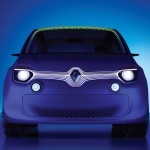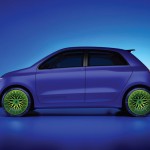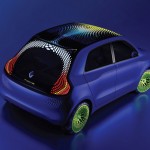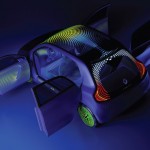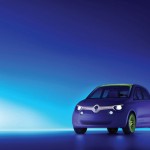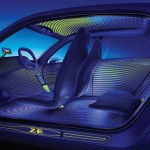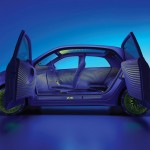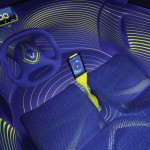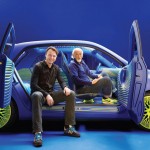Renault’s reputation for innovative design is world renowned, and now visitors to the London Design Festival will be able to familiarise themselves with the French marque’s ‘joie de vivre’ for themselves.
The annual design event, which this year is running right across the capital from 14th to 22nd September 2013, will feature Renault for the very first time.
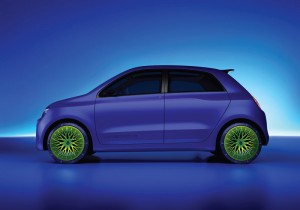
Using the glass ‘tank’ at the Design Museum in London’s Shad Thames, Renault’s striking installation focuses on Twin’Z. The one-off creation, a 100% electric city car concept, borne out of a collaboration with British designer, Ross Lovegrove is sure to draw in the crowds flanking the River Thames at the Design Museum, close to Tower Bridge. Those unable to make the Festival will still be able to see the car on display until 1st October.
Its UK presentation is the first time the car has been seen in public since its unveiling at the Salone Internazionale del Mobile di Milano, the flagship of the design industry’s annual calendar.
As an added enticement, for one night only (Monday 16th September), Renault’s head of design, Laurens van den Acker, and British designer, Ross Lovegrove, will be co-hosting an exclusive soiree to discuss the car and its design.
The purely electric Twin’Z, was the first of two similarly proportioned concept cars from the avant-garde French manufacturer alluding to its future city car. Fun, modern and striking, it is an artistic take on a modern five-door vehicle. It sought to underline the intrinsic importance of design in the worlds of both cars and furniture.
Sitting alongside the River Thames, showgoers will be able to identify for themselves the inspiration which Twin’Z has taken from iconic Renault models of the past, including the 5 and first-generation Twingo.
It represents “Play”, the fifth concept car in a sequence created by Renault’s design strategy surrounding the notion of the human life cycle, illustrated as a six-petalled flower. This strategy fits perfectly with the brand’s determination to accompany its customers during the key phases of their lives and with their individual aspirations.
The DeZir supercar, shown in 2010, embodied the experience of ‘love at first sight’, and inspired the look of the current Clio. It was followed up by Captur, which stood for exploring the world as a couple. Then came R-Space, which symbolised the founding of a family. Representing the world of work came Frendzy.
“We are delighted that Renault and Ross Lovegrove have chosen to showcase the eye-catching Twin’Z concept car at the Design Museum. The car demonstrates how state-of-the-art materials and the latest 3D modelling techniques are shaping modern design.”
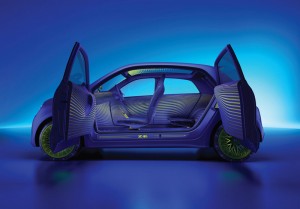
Josephine Chanter, Design Museum Head of Communications
British designer Ross and his team, worked on the futuristic interior and exterior design ‘flourishes’, inspired by the world of nature, with a strong focus playing on light and organic forms.
Ross Lovegrove’s team was tasked with providing the finishing details to Twin’Z’s bodywork (bumpers, lights, grilles, LED roofscape, wheels) which was based on a design produced by Renault Design. His studio was also responsible for designing the interior, including the choice of colours and materials, in conjunction with Renault.
At Renault, the project was overseen by Laurens van den Acker, Axel Breun (Concept Car Design Director) and Raphaël Linari (Designer).
“Renault Design must remain attentive and open-minded at all times. We need to be attentive to new trends in order to stay ahead of the game, while an open-mind that embraces all sectors of activity is necessary to inspire innovation. There are numerous bridges between the work of Ross Lovegrove – which combines beauty and intelligence thanks to an approach inspired by the living, natural world – and the strategy we have been working on for three years now at Renault, producing designs that are sensuous, based on simple emotions and close to the public.”
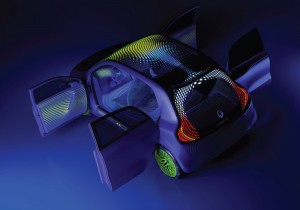
Laurens van den Acker, Senior Vice President, Corporate Design, Renault
Thanks to its architecture, which features a rear-mounted motor, rear-wheel-drive and batteries located beneath the floor, it frees up exceptional cabin space. It also delivers high quality handling through rear-wheel-drive, which makes it a delight to drive.
Twin’Z’s forms and stance are key influences in the overall impression it exudes. Although only 3.62 metres in length, Its proportions, high waistline and the way it sits squarely on its 18” wheels, suggest robustness, reassuring protection and quality.
Blue is the colour…
Twin’Z’s striking blue livery pays tribute to the 20th century French painter Yves Klein. The satin finish gives a pure skin to the body which appears to be coated, almost anodised, rather than painted, suggesting that the pigmentation is inside the body and not applied. The soft clear-coat finish produces a velvet-like feel, while a certain iridescence lifts the car’s ‘electro-natural’ appearance.
“It echoes France’s cultural heritage while also mirroring the virtues of our planet. After all, isn’t the Earth blue when seen from space?
For me, the car is just a big product. But the magic for the designer is having the potential firstly to concentrate on working within the boundaries of a single ‘project’, then secondly to be able to design the furniture, lighting and electronics. I adopted a coordinated approach to both the inside and outside to ensure that Twin’Z read as one object and benefited from the same artistic mind-set founded on digitising and electrifying the car.”
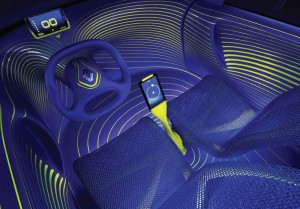
ALL IN ONE
“The car has become a symbol of our progress and civilization; an icon of our technocracy and our ability to transform materials into objects of great precision and physical presence.
The use of composites and recycled materials opens up new opportunities to combine textures and new skin expressions. Mechanical ‘hard’ aesthetics are making way for the biological principles of ‘soft’ aesthetics.
As a consequence, designing a car no longer consists merely in improving the look and feel of the drive experience. It involves harnessing a new attitude towards how we integrate vehicles into everyday life by reducing harmful emissions, dematerialising the car’s physicality to achieve lightness, and maximising not only its footprint but also, and above all, its efficiency and intelligence.
That is what I wanted to achieve through this project.
Thanks to advances in digital modelling, the frontier between dream and reality is becoming increasingly hazy. It is now possible to create objects which feature a strong design yet which still meet the needs of consumers.
From the start, the intention was to build on the heritage of luxury and grace associated with France and to express it in a modern way, while at the same time creating a link between Renault’s past, present and future.”
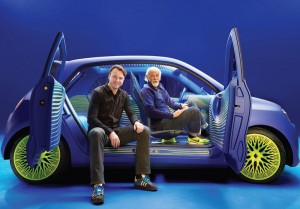
Ross Lovegrove – Designer
Twin’Z – contemporary inside and out
The grille design creates a vortex effect which channels air flow and minimises turbulence to optimise Twin’Z’s aerodynamic performance. The same motif has been embossed into the rear bumper as an echo of the lighting signature.
Twin’Z’s front and rear doors are hinged at the front and rear respectively and open electrically. The resulting absence of a central pillar allows the entire cabin to be revealed to the eye and frees up space to facilitate ingress. This arrangement, which opens up the car’s interior to the outside world, is not only ergonomic but also enables this compact car to break free from convention. As an object, Twin’Z is both precious and high-tech, and this is apparent in the touch-sensitive buttons employed to open the electric doors.
The wheels and tyres have been designed as a single entity. The wheels themselves feature a glowing green finish and their design is based on intelligent growth structures inspired by nature. The solid central core splits into slender branches which strike out towards the rim. The tyres, which were developed specifically by Michelin, continue this pattern to provide a unity between the two functions. As a consequence, the wheel is perceived as a whole rather than a simple juxtaposition of distinct elements. This design was made possible by parametric modelling and 3D printing in order to achieve an eye-pleasing structural unity.
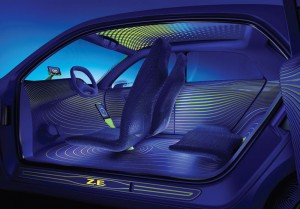
A fascinating play on light that symbolises energy
Twin’Z’s all-LED lighting allows controlled light patterns to be obtained and emphasises the car’s lighting signature. The headlight assembly has been reduced to its graphic intent using the minimum of lines to communicate a positive, alert expression. Crowned by an eyelid, they provide Twin’Z with an optimistic lift. Meanwhile, the daytime running lights are technological gems which form a structure of strips redolent of an iris. In addition to contributing to the front end’s anthropomorphic feel, they bestow Twin’Z with a near-humanlike gaze.
A sequence of LEDs also extends from the grille to the rear bumper via the roof. A pattern of light originates from the Renault lozenge badge and flows towards the head lights before climbing up over the windscreen pillars, along the roofline and then back down to the rear bumper. This light path creates a magical effect which appears to bring Twin’Z alive.
The glass roof is designed in layers and incorporates an array of LEDs which form animated patterns that expand the occupants’ experience.
“Passengers are hooded in a technological envelope that bathes them in a light which responds to the energy and pulse of Twin’Z”
says Ross Lovegrove. “This roofscape heightens the sensation of space and blends seamlessly into the rear window.
The conventional door mirrors have been replaced by an integrated video camera that has been aerodynamically ‘liquified’ within the body. A crystal rear spoiler not only generates extra downforce but also completes the aesthetic flight of the car in a dynamic sense, creating visual lift and a sense of lightness.
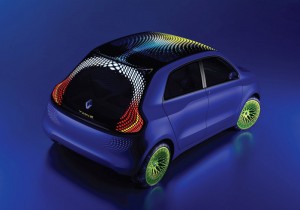
The rear clusters have made way for LED lighting incorporated into the glass. This concept permits a host of new ideas. For example, when the driver presses on the brake pedal, the burst of the brake lights climbs gradually towards the roof, for enhanced visibility and safety.
The name of the car is picked out in gold letters on the rear window, while the ‘LOVEGROVE’ signature has been moulded into the bottom of the front doors.
The rear-hinged rear doors and the ensuing absence of a B-pillar reveal a panoramic view of the cabin, creating a sense of purity and lightness:
The purity of the interior’s lines is picked out by a voluptuous path of light. These milled bi-colour lines circulate round the entire cabin to describe a flow of energy, lighting up the interior with a luminescent green that maps its topographical forms. They treat the cabin as a single landscape to heighten the impression of space.
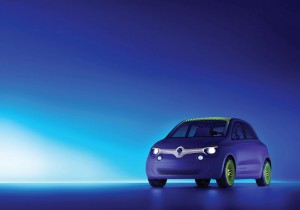
The four lightweight seats have been rendered as small as possible, providing support whilst being lightweight and dematerialised. Their green frames appear to grow naturally from the floor and have been upholstered in a 3D woven, self-cushioning, lightweight blue textile which is both waterproof and flame-resistant, yet which still breathes. The seat frame is visible behind the weave to create an almost aerial feel. Meanwhile, LEDs have been embedded into the frame’s branches to pick out their forms and illuminate the interior.
The eye is drawn irresistibly to Twin’Z’s steering column, inviting you to climb behind the wheel. There is no dashboard, which means that front occupants enjoy exceptional room, as do the rear passengers, thereby ensuring that all the occupants benefit from the same experience.
Use of HMIs (Human Machine Interfaces) has been minimised, too, with the conventional dashboard making way for a single tablet with a touchscreen display that is mounted on a centrally-positioned post. Much like a home automation system, the tablet takes care of everything, from the vehicle’s systems (heater, seat adjustment, lights activation, control of the roof) to the GPS guidance system and in-car connectivity. A smartphone located in the driver’s line of sight display’s the vehicle’s speed, range-related information and the principal warning lights.
More information on the London Design Festival is available at www.londondesignfestival.com
Source; Renault
